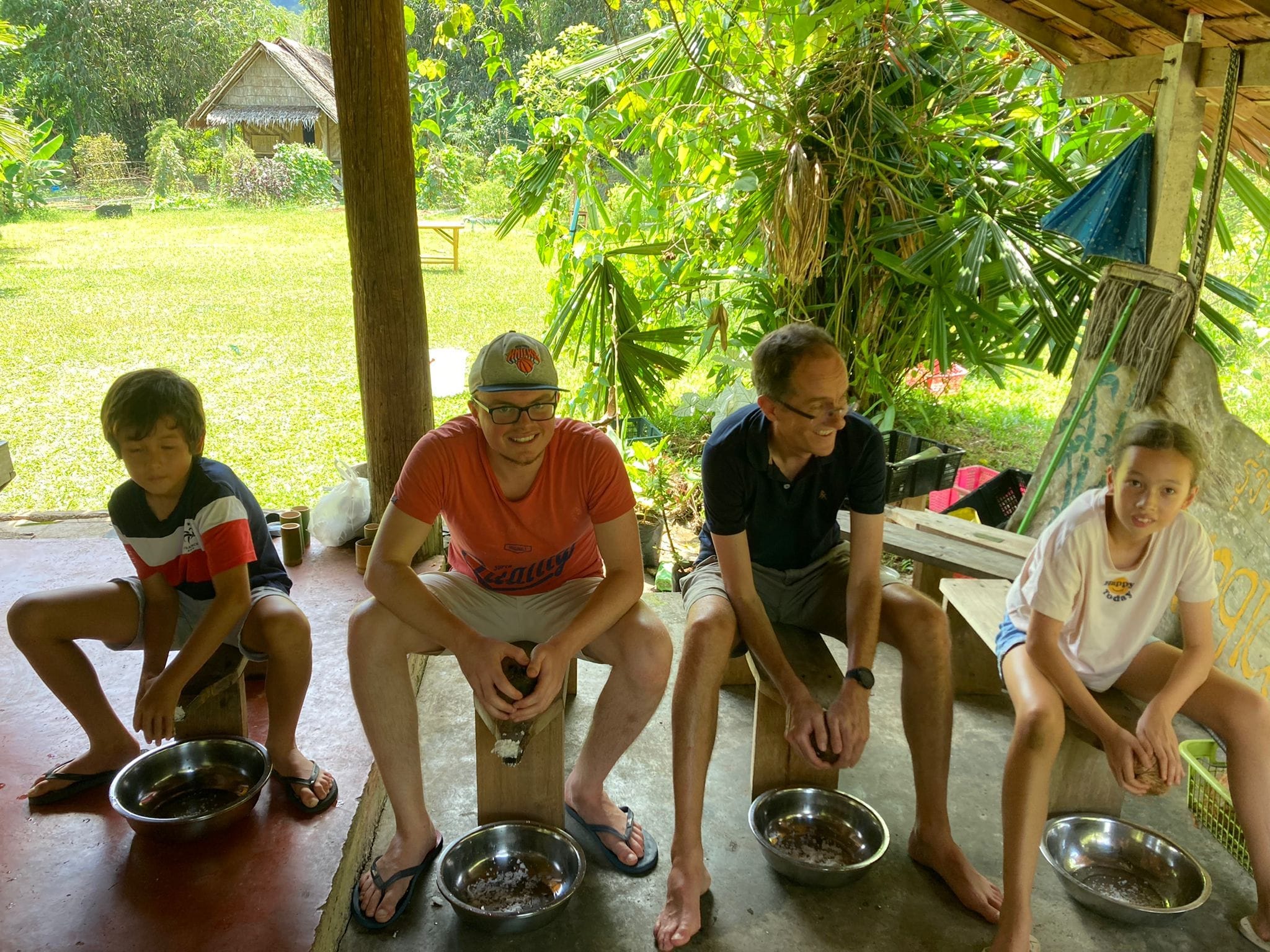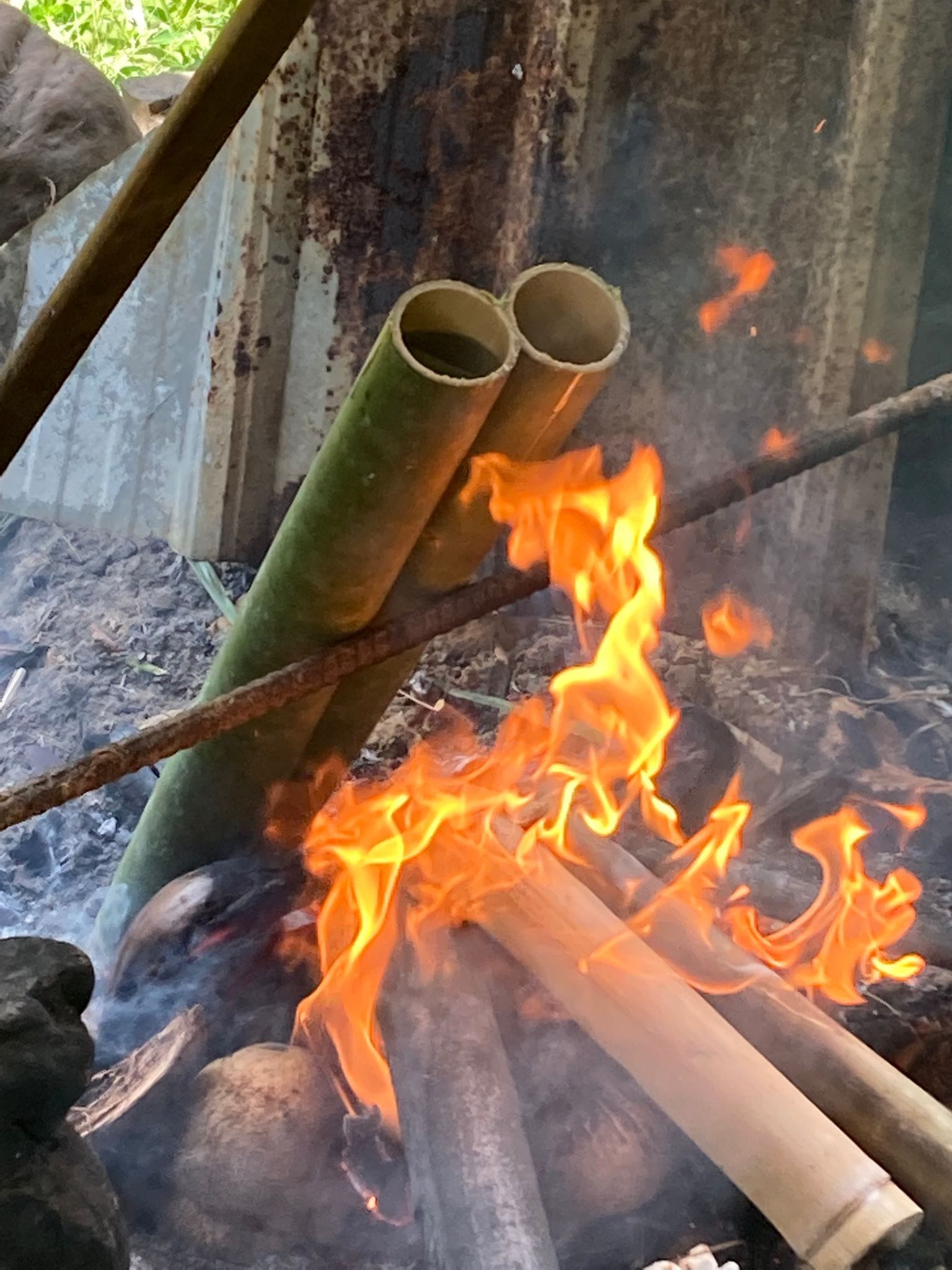The Red Envelope: Billkin and PP Krit’s Take on a Love Story Beyond the Grave
In a cinematic landscape saturated with remakes, reboots and sequels, you might ...

It was mid-day. Under the sweltering heat, we stood on a vast stretch of farmland, overlooking the horizon of towering karsts among the tropical foliage off Khao Sok National Park.
To our right was a spacious hut, embellished with a straw-thatched roof to keep out the heat. The hut interior comprises several long rows of wooden tables and benches. The ones nearer to the hut entrance were meticulously decorated with banana leaves, weaved bamboo trays and condiments neatly arranged in pretty heart-shaped porcelain dishes. Further to our right opened up to another enclosure where charcoal stoves, ceramic pots and a cornucopia of culinary essentials were stored. Nestled in nature’s wilderness, Rungfah Farm Stay is a humble space with an inexplicable sense of serenity. Our inaugural traditional Thai culinary adventure starts here, out in the wilderness of nature.
Our host is Thai. With a lean olive built and warm demeanor, he struck me as someone who has a knack for hands-on tasks and who has spent a considerable amount of time outdoors in the sunshine. Everyone calls him P’yoo, or big brother. P’yoo has worked as a travel guide for more than a decade before setting up his own farm.

We started our Thai cooking class by touring and picking lunch from P’yoo’s impressive food garden. Lemon grasses, native peppers, bird eye chillies, luffas, roselles and sweet kaffir limes were some of the small crops we got to lay our hands on. Holding a hand sickle, P’yoo shared his wealth of local botany knowledge, culinary history and the endearing lost art of traditional Thai cooking practices as he helped us pick the ingredients. We learnt that the Luffa plant, also commonly known as loofah, is edible and is part of the cucumber family. When the plant matures, it is then used as a loofah to rid our skin of dead cells. In Thailand, sweet kaffir limes are known for their medicinal concoction for coughs when mixed and drunk together with honey and salt.


To trace the origins of Thai cuisine is as elusive as finding a needle in a haystack. Thai culinary culture is dynamic and has undergone unprecedented changes. From preparation to presentation, every part of the process evolved from one era to the next to reflect the prevailing needs of the environment and society of its time.
Baking and grilling for example, were commonly used techniques in the preparation of traditional Thai food until the Chinese immigrants started settling in the region. They introduced stir fry and deep-fry techniques, where as a result, Phad Thai (stir fried noodles) and Khao Pad (fried rice) remain popular in Thailand till this day.
Although Thailand is renowned for hot and spicy dishes, chillies were only introduced in Thailand when the Portuguese missionaries, who had taken a fancy towards the fiery ingredient with its roots traced back to South America, arrived in Thailand during the late 1600s. The Thais were also known to have swapped ghee – an ingredient commonly used in India, for coconut milk in Thai’s popular curry dishes.
Besides picking out fresh organic ingredients, one other joyous highlight at Rungfah Farm Stay was to be able to fully immerse oneself, and experience cooking in the most traditional and primal way.

As we stood around the rows of wooden tables that graced the entrance to the hut, we carefully laid out the ingredients picked earlier, on bamboo trays next to the condiments. There was an old style huge mortar, accompanied with a pestle, which we would be using to mix and manually pound ingredients to their finest grains. Steel woks were set aside atop charcoal and fire stoves and we spent the rest of the morning labouring away to our hearts’ content. Chopping, slicing and peeling the fresh produce we picked out in the morning.


Coconut milk is one of the staple ingredients in many Thai recipes. At Rungfah Farm Stay, we learnt the art of extracting it manually from fresh coconuts. We used the hand tools provided to first rip open the husks and then sat on traditional wood graters as we worked our hands to maneuver and rotate the husks on an attached metal blade to grate out the coconut flakes, which were then collected at the bottom of the grater.

Rice was prepared by wrapping the grains and sealing them tight with toothpicks in banana leaves. They were then stuffed inside bamboo tubes half filled with water and cooked over charcoal fire. This gives the rice a unique aromatic flavor when the water inside the bamboo tubes is infused with the smoke of fire. We gathered around the tables once again when lunch was ready and then served in long bamboo troughs. Wok fried vegetables, Thai red curry, deep fried taro fritters, chicken in creamy coconut milk and jasmine rice cooked on fire. Food was particularly palatable. As laborious as it was, we were consumed by a sense of well being, connectedness and joy.



Cooking has long been considered therapeutic because we not only get to indulge in our own creativity, the satisfaction of providing food for ourselves evokes a sense of well-being. It has also been an important source of social and emotional connectedness forged when we cook, not just for ourselves but for friends and families. Since the dawn of civilization, food has always been a social glue transcending across cultures and traditions.
Inevitably, the change of times, proliferation of urban dwellers in major cities and the lifestyles we have since adopted has shifted that primal connection we have had with food. We see ourselves gravitating towards swapping home cooking for fast food and consuming more preservative laden food in the name of convenience. As we head down this rabbit hole that compromises our own health, we, unknowingly, are also abandoning the enduring values and traditions of culinary art passed down from earlier generations that form a part of our identity.

In Thailand, the agriculture sector employs 30% of the nation’s labour force, equivalent to over six million households. However, the sector’s contribution to national income has been less than mediocre. Farmers continue to struggle with hardly any signs of visible upward trends due to a combination of social and economic factors like an aging labour force, expensive land ownership and resource scarcity.
Urban consumers, on the other hand may seem to have access to an abundance of food choices, leveraging on a centralized network, but this system of control is primarily dominated by a small handful of food conglomerates. These typical “middleman” arrangements mean that profits ultimately outweigh any form of economic and social responsibilities towards farmers and consumers. This most evident disconnect on both ends of our current food supply chain between urban consumers and the rural farmers is causing a rift. The more we ignore this imbalance and normalize the disconnect between us and farmers, the more damage we inflict on our food system. We are part of a whole in this connected supply food chain and should any parts fall off the grid, other values important to us fall apart as well. Quality of life, human health, community resilience and the preservation of our natural ecosystem are at stake.

A magnificient view with unexplicable serenity
A culinary experience manifested in the form of tourism like Rungfah Farm Stay offers not just an experience to connect with local traditions and culture, it opens a window of opportunity to reflect on our reality with food. As individuals, we can strive to shift habits to influence and to bridge this rural-urban food divide.
In Bangkok for example, eateries and restaurants that are ahead of their times are already doing more than just choosing local over imported produce or mindfully selecting seasonal produce. Some are already creatively experimenting with native ingredients and indigenous crops in their menu to curate seasonal dishes for diners. This not only prevents unnecessary food wastage but also enriches the biodiversity of native botanicals. There are also digital food start-ups that have bravely taken on the reins to offer a platform where consumers can have direct access to farmers who offer fresh organic produce.
As consumers, staying informed, knowing our options and making a decision to influence a positive outcome is key. Whether we decide to start cooking more at home, growing food in our own homes, mindful with our food purchases or choosing to dine at food responsible eateries, a food system that is both resilient and sustainable is all about the food choices and decisions we make as a consumer – Food for thought.
This article is written by Joey Ho Meng Guet, a Singaporean freelance writer based in Thailand.
In a cinematic landscape saturated with remakes, reboots and sequels, you might ...
Find out more about your celeb favourites and their most loved vacation ...
These top 5 barber shops in Bangkok are where gentlemen can elevate ...
While traditional TV shows are serving us endless boy-meets-girl tales. Thailand has ...
Sailorr and Molly Santana’s black grills fuse hip-hop swagger with homage to ...
Netflix Thailand has officially announced a new price for base subscriptions We’ve ...
Wee use cookies to deliver your best experience on our website. By using our website, you consent to our cookies in accordance with our cookies policy and privacy policy